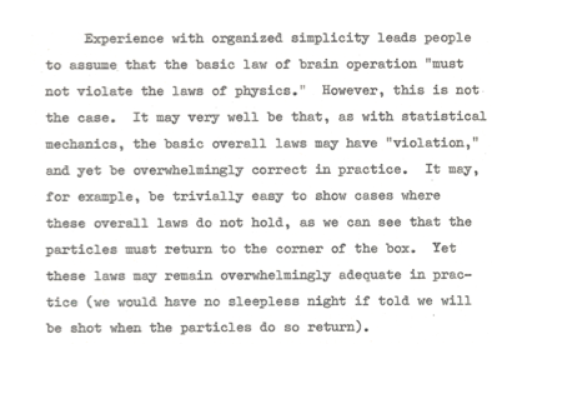Selected Quotes
Categories
- ART 7
- ENACTIVISM 7
- EVOLUTION 5
- GOD 9
- HEBB 3
- HISTORY 7
- HOW THE BRAIN WORKS 18
- MENTAL ILLNESS & etc. 8
- OVERVIEW OF MODEL 16
- PROBABILITY 1
- SCHISM 3
- UNIVERSAL MODEL 5
- VALUES 19
- VARIOUS QUOTES and BUNDLED QUOTES 4
- WHEELER 7
- WORD 19
- x A LIST of SYMBOLS & DIAGRAMS & PICTURES 3
- x Additional Putnam Quotes 17
- x BARRY comments on paper FORMULATION of VALUES 1
- x Transcriptions of Putnam_Spinello conversations 3
All Tendencies within a Person are Correct - with a BJS comment
Formulation of Values 2/16/57 pg 16
PUTNAM: “To plead for friendship, to be self-restrained, to be angry, to be subservient, to be able to assume and give expression to all such attitudes, does not lead to chaos. Accepting this broader sympathy makes the resolving as between them susceptible to verbal regulation.”
BJS - What this means is that within the drama shop of your self, be able to step back and sort-out and categorize the edge of your feelings - how you are acting, or behaving that very moment…
—‘Ha! Now I am the Buddha of anger! - and now of remorse! - and now of joy!, etc. etc.’
Remove yourself to a slight distance and so be able to see and evaluate yourself in action. See that within yourself you have the many tendencies, and knowing this you can see which you are using and when. You are thus not at the edge of, or run around by, or led by your tendencies or immediate feelings. Knowledge of this, or about this, is gained by experience in living, but also can be aided by understand the model (how the brain works) and thereby an aid in developing the mature life skills and patterns.
“The Model” provides insight into self - for those struggling for identity.
On the one hand this is the only struggle.
On the other hand it is vain pursuit for only God (probability) rules.
To recognize this discrepancy is a toehold into the model.
All Areas of the Brain function as the Same
Putnam-Fuller NS model 1964 pg
“there is a vast body of evidence pointing to the uniform functional character of all areas of the brain. Areas differ only in the parameters of this common function, as for example time constants, and ratio of cells of different “type”, and in the areas linked by the wires that come and go, etc. The uniform functional character of all areas force us to look to the structure of the environment, or the inputs themselves, as the source stabilizing internal structure.”
“Special brain centers do not represent a violation of this simple functional picture. Rather they reflect the correlated nature of the environmental inputs, and their breakup into such classes for special processing.”
SEE JOACHIN FUSTER LECTURE
SEE Coleman Clarke’s letter to BJS re ALL AREAS OF THE BRAIN SAME

















